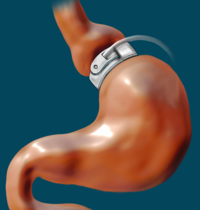
Photo from wikipedia
DEVELOPMENT OF THE NBI endoscopic system (Olympus Medical Systems, Tokyo, Japan) started at the National Cancer Center East Hospital by Dr Sano, Dr Muto and Mr Gono under the leadership… Click to show full abstract
DEVELOPMENT OF THE NBI endoscopic system (Olympus Medical Systems, Tokyo, Japan) started at the National Cancer Center East Hospital by Dr Sano, Dr Muto and Mr Gono under the leadership of Professor Shigeaki Yoshida and Professor Hisao Tajiri in 1999. NBI provides observation though irradiating light with two narrow-banded wavelengths (blue light 390–445 nm and green light 530–550 nm) which are easily absorbed by hemoglobin in the blood, highlighting capillaries and mucosal micropatterns in the mucosal surface layer. As cancerous tissues try to enlarge themselves by expanding blood vessels to take in nutrients, the surface of the mucosa changes into an intricate pattern with more capillaries as cancer expands, thus the use of NBI is helpful for early detection of cancer (Fig. 1). Antoine de Saint-Exup ery once wrote in The Little Prince that “what is essential is invisible to the eye”. He wrote, “anything essential is invisible to the eye. It is only in the heart that one can see rightly. One tends to make judgments based on what one can see and in one’s own way, but what one can see will be gone sooner or later. The things that remain in one’s heart forever lie in what one cannot see”. Narrow band imaging was truly a revolutionary idea. It was the idea of making the invisible visible with the help of science and technology, but it was an eccentric idea born out of obsessive observation, and trying to make the things which cannot be seen visible. I (Dr Sano) still vividly remember that December 14, 1999, when Mr Gono and I
Journal Title: Digestive Endoscopy
Year Published: 2022
Link to full text (if available)
Share on Social Media: Sign Up to like & get
recommendations!